Wednesday, May 3 – Sahara Desert Camp – Camel Ride
We get up early and explore the quiet area outside the camp before breakfast. Many of our fellow travelers join us in the cold morning. Some young local girls set up trinkets, hoping to make an early sell – however, not many takers.
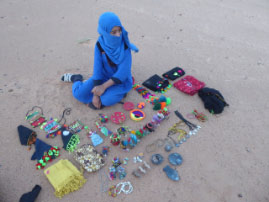
Pop-up trinket shop in the Sahara |
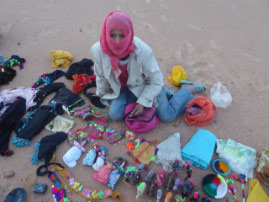
Pop-up trinket shop in the Sahara |
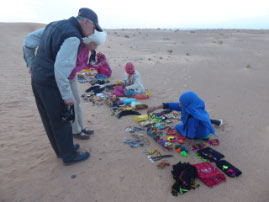
Pop-up trinket shop in the Sahara |
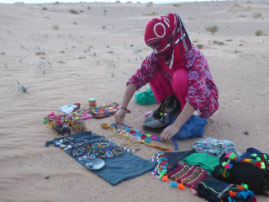
Pop-up trinket shop in the Sahara |
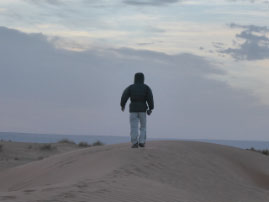
Waiting for the sunrise |
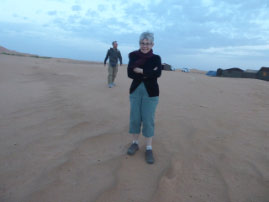
Waiting for the sunrise |
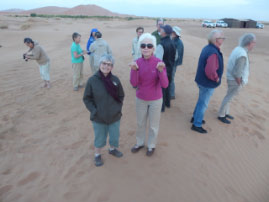
Waiting for the sunrise |
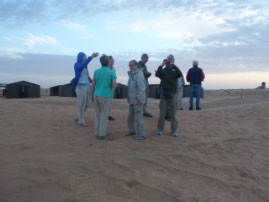
Waiting for the sunrise |
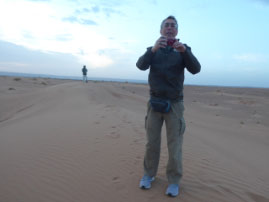
Waiting for the sunrise |
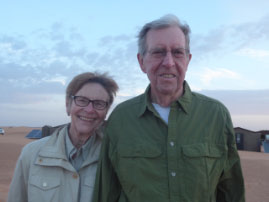
Waiting for the sunrise |
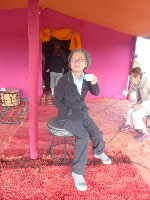
Breakfast |
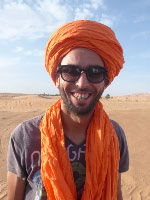
Nour |
After breakfast, Nour ties my headscarf the proper way for camel riding – so I am READY! I can’t tell you how thrilled I am to get to ride a camel in the Sahara – a dream come true and on a perfect day.
We set off in our 4X4’s heading to the herd of camels. We see the camels and the wild and crazy camel guides. They help us mount the camels and we’re off. Joan is worried that her back won’t like camel riding, but she’s willing to give it that old college try. (She manages about a 15 minute ride – and that is a victory for her and all of us – BRAVO Joan for trying.) I was on a high, loving every minute. I can die now. I did go overboard with the photos – here’s only a small subset of them.
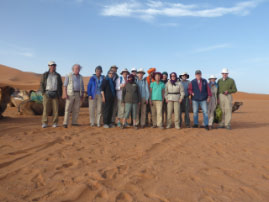
Getting ready |
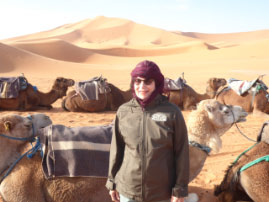
Getting ready |
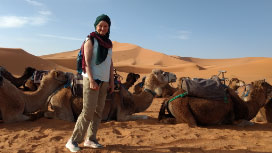
Nancy and her herd |
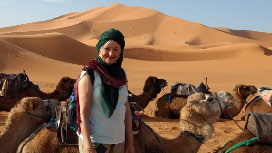
Nancy and her herd |
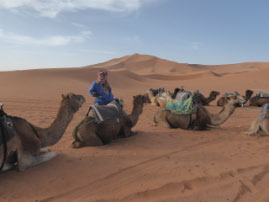
Camel ride |
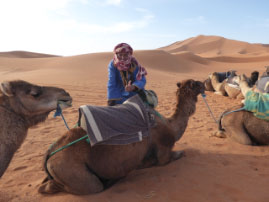
Camel ride |
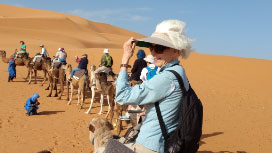
Camel ride |
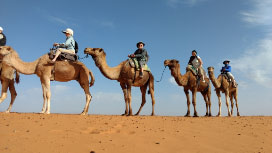
Camel ride |
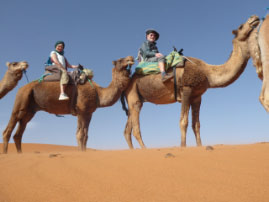
Camel ride |
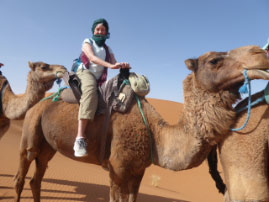
Camel ride |
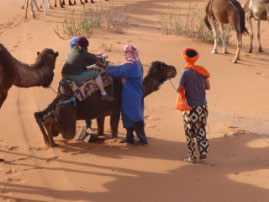
Camel ride |
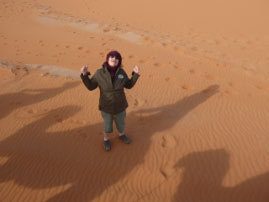
Camel ride |
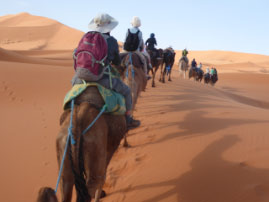
Camel ride |
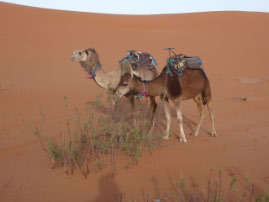
Camel ride |
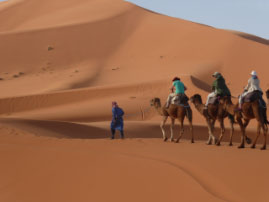
Camel ride |
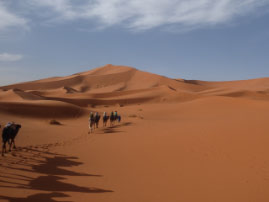
Camel ride |
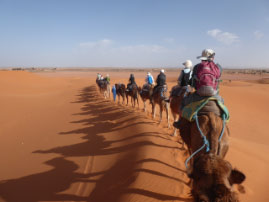
Camel ride |
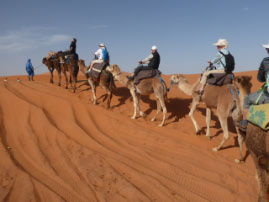
Camel ride |
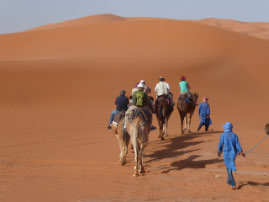
Camel ride |
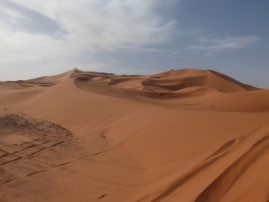
Camel ride |
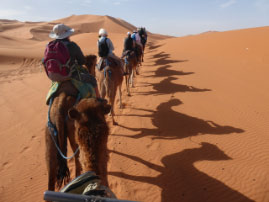
Camel ride |
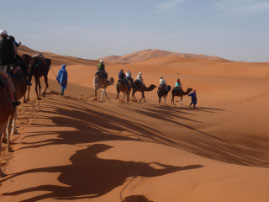
Camel ride |
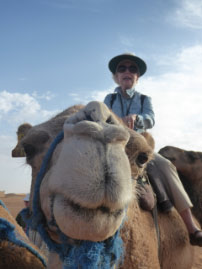
Kathy and the Beast |
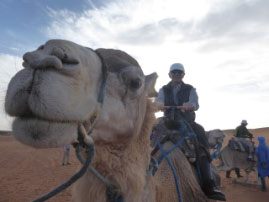
Rex and the Beast |
We end our ride in an old desert town. After saying good-bye to the camels, we set off in our 4X4’s to visit a local farm and learn about the local produce and vegetation. We meet the farmer with his granddaughter. He is a sweet adoring grandpa and very knowledgeable. He shows us his date trees, and even climbs one. He tells us how to cross pollinate the trees in order to produce dates. He is most proud of his irrigation system. It appears crude, but it does the job on his gardens. He is also very proud of his new crop of baby goats – so nice to hold.
The little girl, like most Moroccan kids I’ve meet, is spunky and independent. I love her confidence and strong will. I don’t know if she’ll go to school or not – but one thing for certain, that kid is in charge and knows what she wants!
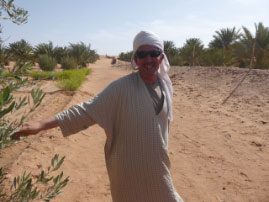
Visiting the farm |
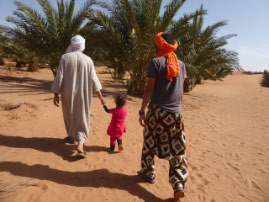
Visiting the farm |
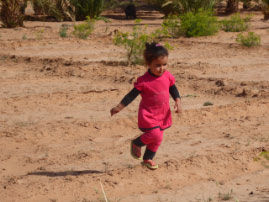
Visiting the farm |
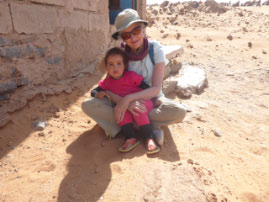
Visiting the farm |
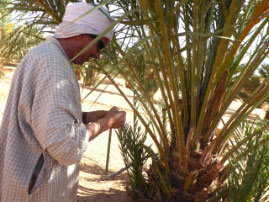
Visiting the farm |
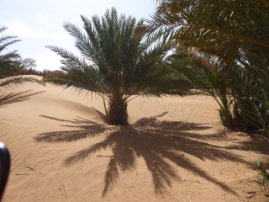
Visiting the farm |
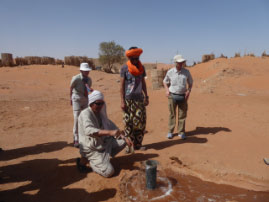
Visiting the farm |
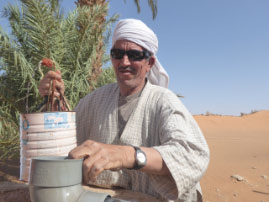
Visiting the farm |
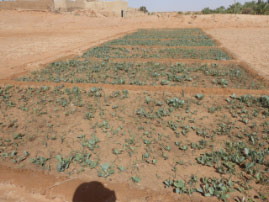
Visiting the farm |
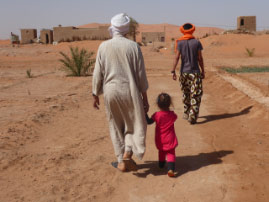
Visiting the farm |
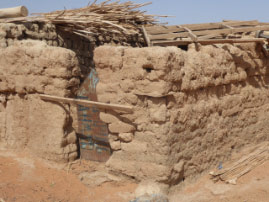 Visiting the farm Visiting the farm |
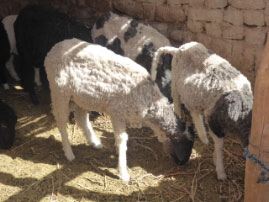
Visiting the farm |
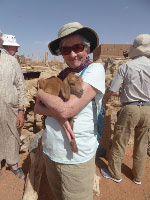
Visiting the farm |
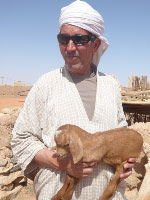
Visiting the farm |
After hugging a goat, we head to Khamlia, a remote desert village in the shadow of some of the biggest dunes in the Sahara. The isolated town, with a population of about 150 people, has three small shops, a coffeehouse and a school. The majority of the people are black and descendants of slaves originally captured by the Arabs during the 17th century in Guinea, Mali, and Sudan and brought across the Sahara to feed the slave trading business for Europe and beyond. The slaves were also used to serve the sultans in Morocco.
Over the years, their closed culture has developed their own unique style of music – blues-like style with patterns of call-and-response -- blending ancient African Islamic spiritual religious songs and rhythms.
They also have their own style of instruments like the bass lute or gimbri. Other instruments add to the eerie melodies. A willow stick, reminiscent of the slave owner’s whip, is used to tap out the rhythms and metal castanets represent the chains of bondage.
I found the music has a haunting and hypnotic effect on the listeners. These guys are the real deal. I can see why many feel the music is not just entertainment. It has a deeply rooted spiritual and healing purpose that comes from the Sufi tradition of Islam and ancient sub-Saharan African rituals. The healing ceremonies, or lilas, take place from dusk till dawn and are conducted by a priestess who invokes ancient African spirits and Islamic saints. For many years, Moroccans shunned and feared the powers of this music, but now it is openly performed, pulling in the crowds. (The annual Gnaoua & World Music Festival in Essaouira attracts over 400,000 fans.)
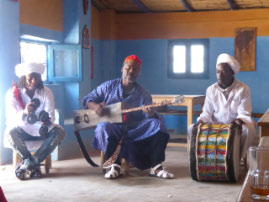
Unique music |
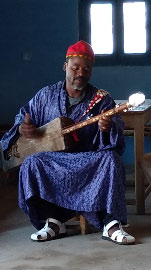
Unique music |
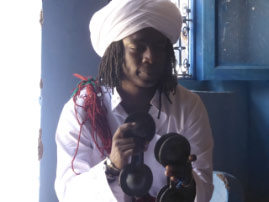
Unique music |
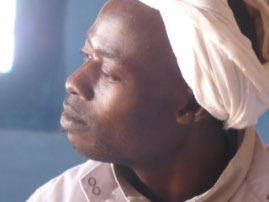
Unique music |
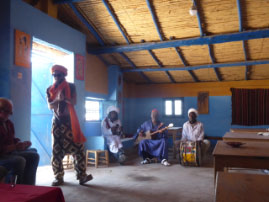
Unique music |
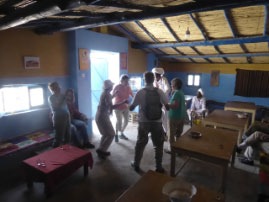
Unique music |
After our most enlightened concert, Nour takes us to a Muslim graveyard and explains the burial customs. In the Islamic tradition, family members wash and bury the body of their loved one within 24 hours. They avoid embalming fluid and caskets so the body can return more naturally to the earth. After the body is washed, the hands are laid across the chest as if the corpse is praying. Next a large piece of cloth (shroud) is wrapped tightly around the body. Using his own body, Nour demonstrates the position and direction the body is laid in the grave. Nour can’t lay on the ground too long because the rocks are hot. I find the tradition to be very loving and simple.
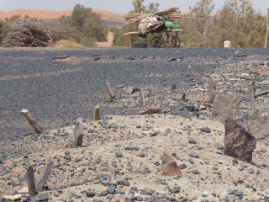
Muslim graveyard |
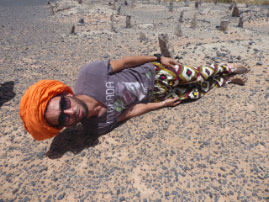
Muslim graveyard |
We return to our camp for “Happy Hour.” The staff makes us a special exotic cuisine, harissa, a fiery sauce made from hot red pepper, olive oil and garlic. (Hope I got that right?!?) The group has bonded even more during our desert adventure. Nour leads a discussion on the basic tenets of Islam before dinner – but none of this accepting group gets steamed because, unlike our fearless / stupid leader (you know of whom I speak), we don’t think Muslims are terrorists who want to kill us.
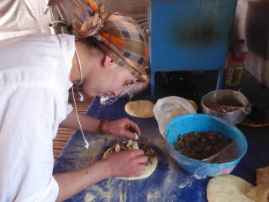
Fiery sauce |

Discussion in the Desert |
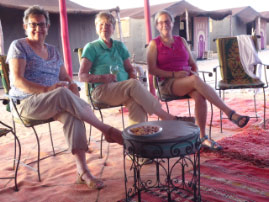
Group Discussion |
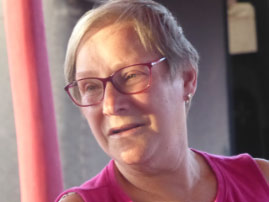
Group Discussion |
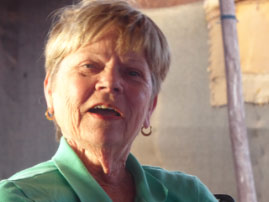
Group Discussion |
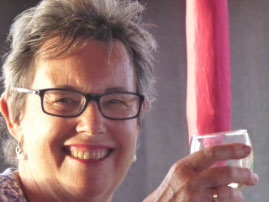
Group Discussion |
After our discussion, I watch the sunset and I celebrate my last night in the magical Sahara Desert.
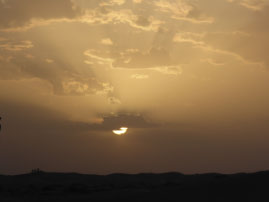
Sunset in the Sahara |
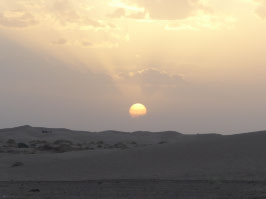
Sunset in the Sahara |
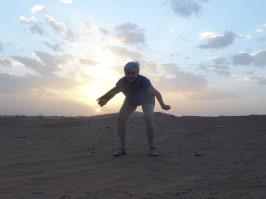
Sunset in the Sahara |
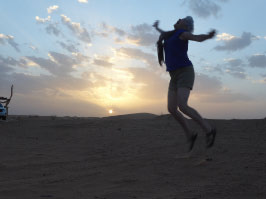
Sunset in the Sahara |
We have a yummy dinner. Afterwards, Nour and some of the staff serenade us with some rocking Berber tunes. Nour was hoping I was taking videos to capture the essence – but haven’t quite figured out the video function on my new camera – Sorry Nour … a star like you deserves better treatment.
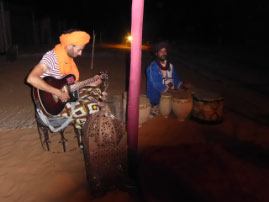
Berber tunes |
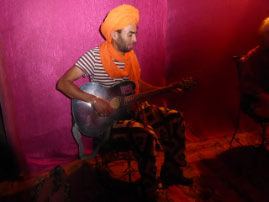
Berber tunes |
Thursday, May 4 – Sahara Desert Camp – Overland to Ouarzazate
Bill gets up early to capture the sunrise in the Saharan dunes. I lay in bed in the quietness, dusting off a thin layer of Sahara sand that has accumulated over the night. After a great breakfast, we pose for our official desert group shot in front of the dining tent.
Our bags are loaded into the 4X4’s and we head across the desert. Our final destination for today is the oasis town of Ouarzazate.
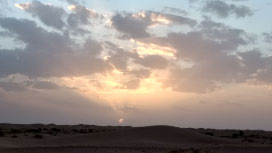
Sahara sunrise |
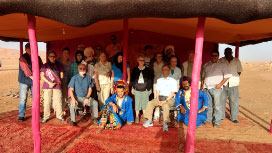
Official Desert Group Shot |
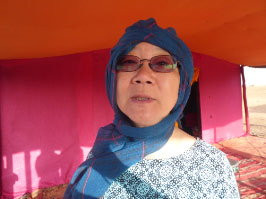
Good Bye Sahara |
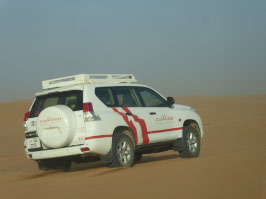
Heading across the desert |
After the dash through the desert dunes, we leave 4X4’s and load back onto the tame bus to continue our trip back to civilization on paved roads.
We make a pit stop at a most unusual place – a combination W.C., fossil shop and a dried up water system that once made the desert flourish. Nour walks us up to a well built up on a small hill. The pit stop owner / entrepreneur cranks the crude, wooden wheel that once brought up water – but now comes up empty. Then he walks us down to an underground tunnel where we can see directly up the dried up well from below. Much to my surprise there are several surrounding tunnels connecting many other wells. It looks like an underground ant farm. Above ground, it’s easy to see many wells placed in orderly lines – making up a once massive irrigation system – gone dry. The owner farmed the land with an abundant supply of water. When the wells dried up, he changed his business from agriculture to tourism – providing a pit stop, a fossil shop and a tourist attraction that gives us a look at very clever abandoned irrigation system. He is a clever guy because his new business model seems to be thriving.
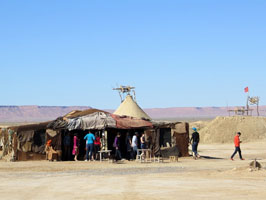
Old water system |
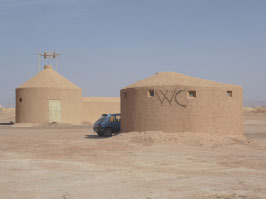
Old water system |
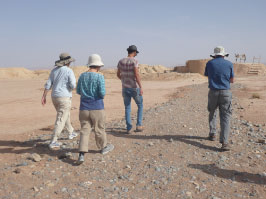
Old water system |
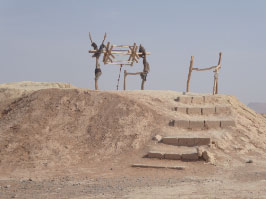
Old water system |
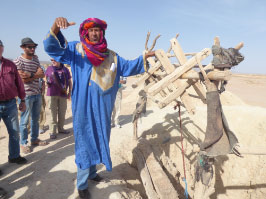
Old water system |
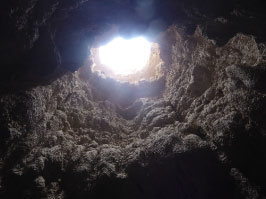
Old water system |
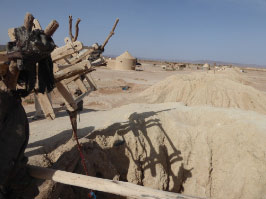
Old water system |
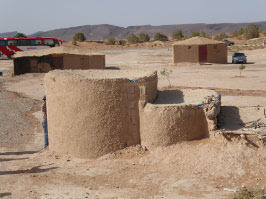
Old water system |
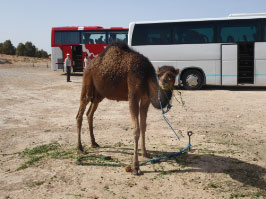
Old water system |
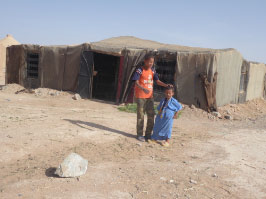
Old water system |
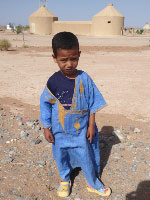
Old water system |
We drive through the little city of Tinejdad with its square minaret (not pictured). People are busy and on the move. I snap several photos from the bus window.
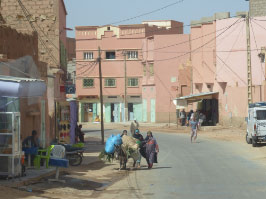
Tinejdad |
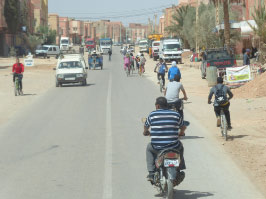
Tinejdad |
Just at the end of Tinedjad is the Ksar of El Khorbat, an ancient fortified walled city. There’s a magical feeling as if we turned the clock back 2,000 years. Unlike their close neighbors Tinedjad, there are no cars, no motorbikes and no hustle and bustle of people on the go. Here a huge wall encases the city and the “streets” are long dark tunnels connecting people’s homes with an occasional open common area that lets the sunlight come through.
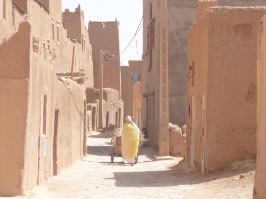
El Khorbat |
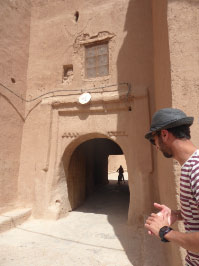
El Khorbat |
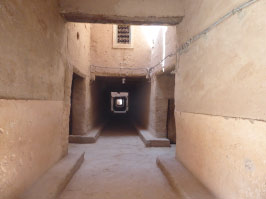
El Khorbat |
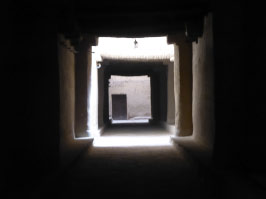
El Khorbat |
The ancient city’s thick walls are still standing with a patch here and there. I am glad to see there are many government modernization projects (e.g., water and sewer facilities) in progress. It’s so important to save this precious jewel of a town and others like it.
We roam around the quiet ksar and meet some of the friendly people who are delighted that we have come to visit. The kid on a bike lets Nour take a spin in the close quarters. A teacher invites us in to meet her first graders. We are all charmed by them!
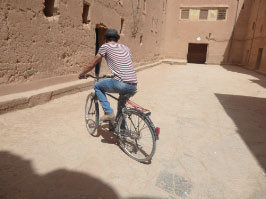
El Khorbat |
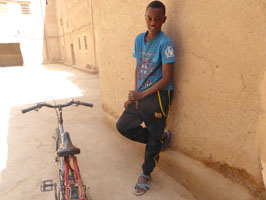
El Khorbat |
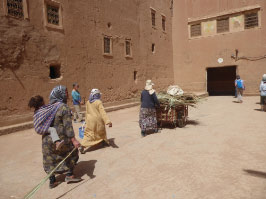
El Khorbat |
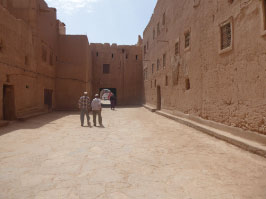
El Khorbat |
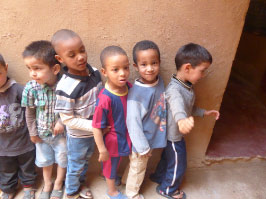
El Khorbat |
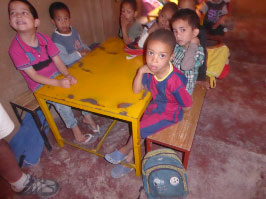
El Khorbat |
Nour takes us around an alleyway or two and leads us to a simple Berber museum. The museum occupies the space that once was somebody’s home. The artifacts are displayed in a series of small rooms occupying three floors and a rooftop patio with pleasant breezes and magnificent views of the mountainous backdrop.
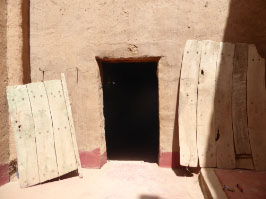
El Khorbat |
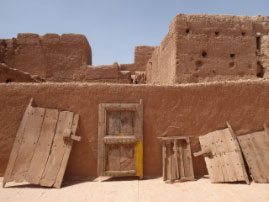
El Khorbat |
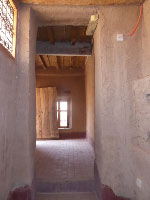
El Khorbat |
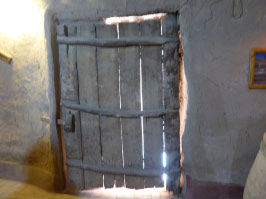
El Khorbat |
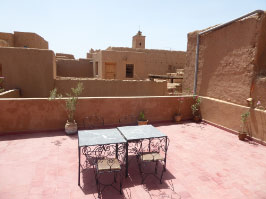
El Khorbat |
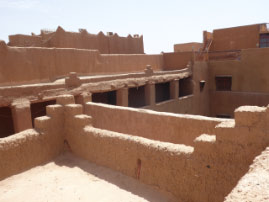
El Khorbat |
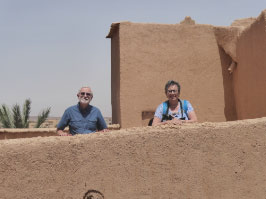
El Khorbat |
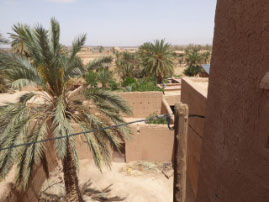
El Khorbat |
A couple of the rooms in the museum are models of a Berber kitchen and living room. They are just like the Berber homes we’ve visited. Also, many of the displays (a plow, baskets, clothing, etc.) are just like what we see all around us, used in day to day life. Not a lot of “progress.” Don’t see a lot of microwaves, blenders, mixers, toasters, etc. in the kitchens we visit.
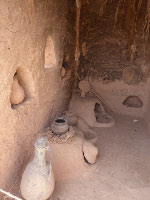
Berber Museum |
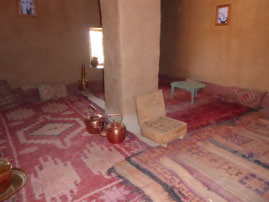
Berber Museum |
I spent a lot of time in the Jewish heritage room trying to figure out exactly what happened to the Moroccan Jewish communities in this ancient city. “Once a strong, prosperous community … now all gone.” The display in this museum says: “The Jews here returned to Israel after the 6-day war in 1967.” Thinking this is Fake News -- Nothing lines up or makes sense.
Another item has me mesmerized with terror. It’s a wooden torture device used to clamp down on one’s head and neck (with nails added for extra pain) – with the Jewish Star of David prominently engraved on it. I am perplexed -- Was the device used for the Jewish people or did the Jewish people use it for their slaves? I often leave museums with more questions than answers.
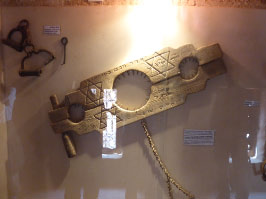
Berber Museum |
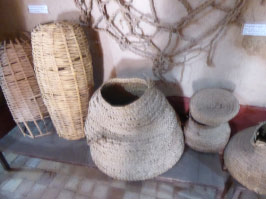
Berber Museum |
After visiting the Berber Museum, we have a lunch in the garden of the El Khorbat Inn. I enjoyed the pleasant oasis environment and the food. Sorry I didn’t snap a photo – guess I just got “snapped out.”
Fat and happy from a delightful lunch, I nap on the bus on the way to Ouarzazate. Playful Nour takes my camera and snaps several unflattering photos of me, sleeping on the bus with mouth wide open, possibly drooling. I deleted them ASAP!
We make a rest stop with an adjacent souvenir shop specializing in rose water and other essential oils. I buy rosewater for some of my girlfriends back home. Roses are big in the dessert with several production distilleries. Rosewater was first used by the Persians centuries ago and now it’s market all over the world as a most essential of the “essential oils.” I like the mild smell (and the long, exotic history).
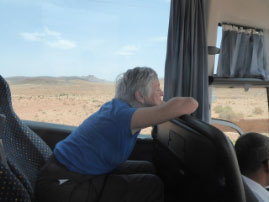
The Bus to Ouarzazate |
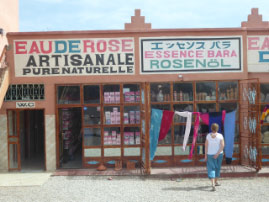
Adjacent souvenir shop |
Later that afternoon we arrive at our destination, Ouarzazate, the country's movie capital. In spite of its 50,000 inhabitants, I am struck by Ouarzazate’s quiet, pleasant laid-back nature and well-kept roads and buildings.
Ouarzazate was built by the French as a garrison outpost in the Sahara. Once an isolated military outpost, it still maintains that frontier-type vibe, even though it’s a major administrative center of the region where you can get anything you want.
Hollywood discovered the place in the 1960s and 1970s, making it a favorite locale for the movie industry. It’s a perfect location with good weather, beautiful mountain ranges, sand dunes and ancient cities all bathed in perfect golden light – and with very reasonable accommodations. Movie making business was good back then. Half the town immediately became “extras” – Always fun living in a fantasy land.
In the 1980s, hotel developers flocked to town and went on a hotel-building spree in anticipation of housing demands for many production teams and their associated cast of characters and big stars. Maybe when CG (Computer Generated) came into the film business, there was less of a demand for cast of thousands in a grandiose, exotic far-away lands – the computer could take care of that. The hotel boom never really reached investors’ expectation – but they did manage to add several really nice resort hotels, like the one we’re staying in. Also, a number of film studios based in the town do attract their fair share of big-budget productions. Coupled with the increasing interesting in Moroccan tourism, the hotels seem to be doing alright!
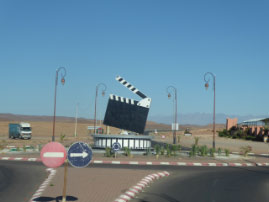
Ouarzazate |
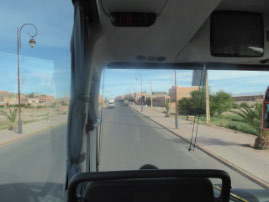
Ouarzazate |
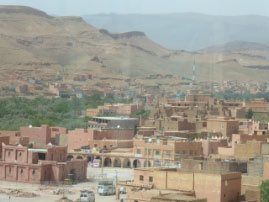
Ouarzazate |
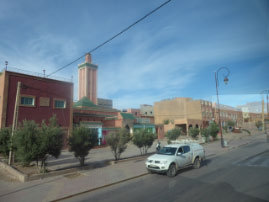
Ouarzazate |
We check into our hotel “Le Berbere Palace,” a luxurious 5-star hotel set in a prime location in the center of Ouarzazate. Many of the production companies in town making "desert" pictures stayed here. Everywhere you can feel the ghosts of past big budget movies.
In the hotel’s massive adobe-built main building are the lobby, a reflecting pool, lounges and several restaurants. Scattered about the common areas are actual props used in the movies - everything from ancient statues to royal carriages and even Cleopatra's throne. Joan and I pose on Pharaoh's throne. Feels like we’re in a Movie Disneyland.
Everyone stays in nice comfortable chalet along beautifully maintained pathways. The hotel grounds are lush and the pool area is like an oasis with many inviting bars. We are indeed very happy here!
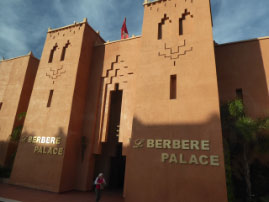
Le Berbere Palace |
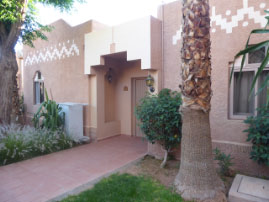
Le Berbere Palace |
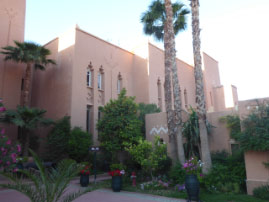
Le Berbere Palace |
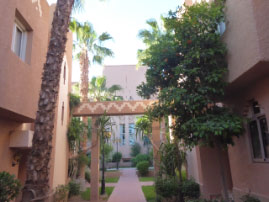
Le Berbere Palace |
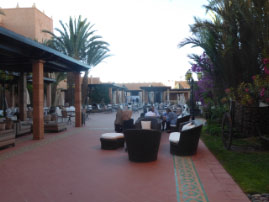
Le Berbere Palace |
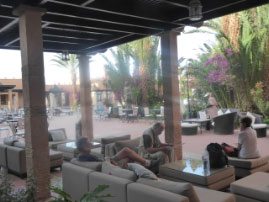
Le Berbere Palace |
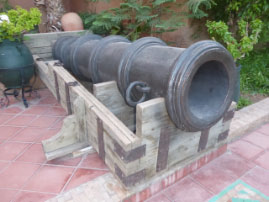
Le Berbere Palace |
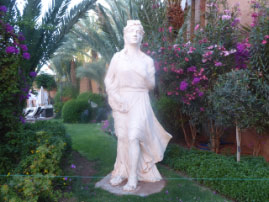
Le Berbere Palace |
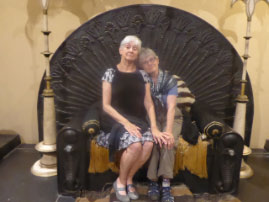
Le Berbere Palace |
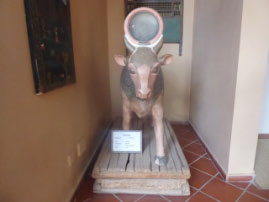
Le Berbere Palace |
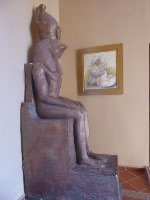
Le Berbere Palace |
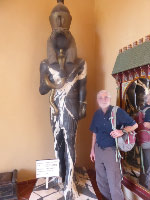
Le Berbere Palace |
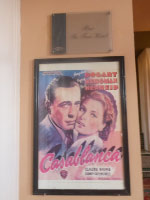
Le Berbere Palace |
We have dinner at a delightful local restaurant. The ambience was just right. The place was cozy and the walls were covered with pictures of famous actors. The food was great and beautifully planted. Musicians entertained us – delightful evening.
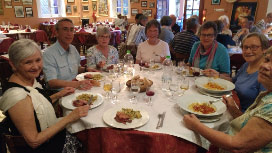
Dinner in Ouarzazate |
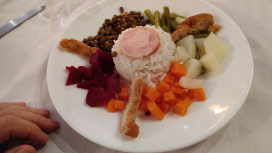
Dinner in Ouarzazate |
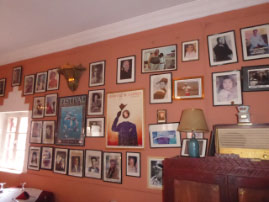
Dinner in Ouarzazate |
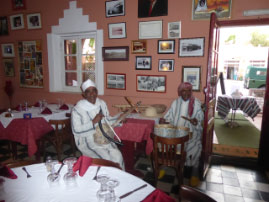
Dinner in Ouarzazate |
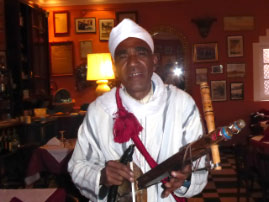
Dinner in Ouarzazate |
Friday, May 5 – Ouarzazate (Zion’s 16 Birthday / Rex & Kathy’s 50th Anniversary)
After a beautiful breakfast, we take a 15-minute drive to Ait Benhaddou, one of the country's most picturesque and best preserved kasbahs. The town is built around the only hilltop in the area and has a commanding 360 degree view. The towering walls, houses, stables, lofts, and even a mosque are all constructed from a mix of red earth and stone (called tabout) – are all connected by a maze of narrow, winding lanes. It’s easy to see why this is designated a UNESCO World Heritage Site. A ruined fortified granary, or agadir, sits on top of the hill. Placing the highly prized supply of grain on top of the hill gave the town a strong defensive advantage.
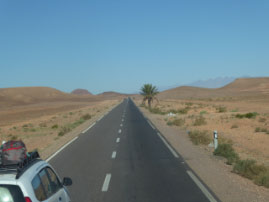
Ait Benhaddou |
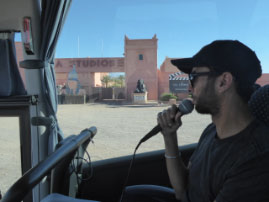
Ait Benhaddou |
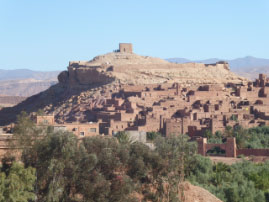
Ait Benhaddou |
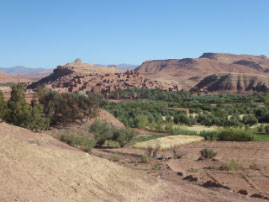
Ait Benhaddou |
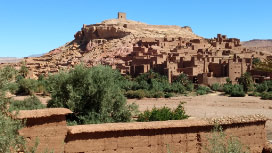
Ait Benhaddou |
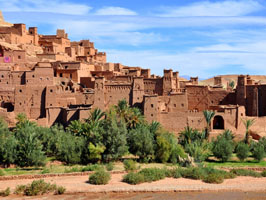
Ait Benhaddou |
Established as early as the 11th century, it was an important stronghold of the clans that controlled the southern caravan trade that passed through here. The town was a Caravanserai for many years providing refuge for travelers and merchants and one of the most important stops on the lucrative West African caravan trade route.
A thousand or so years ago, it was in its prime -- before the west coast of Africa was discovered by the seafaring nations of Europe; before the French built a faster, safer route through the Atlas; and before the border with Algeria was closed. Caravans of more than a hundred camels -- carrying cloth, glass, and other goods from the modern world -- would pass by here en route from Marrakech to the kingdoms of Timbuktu and the old Sudan, returning months later with their booty of gold, ivory, salt, and slaves. Ait Benhaddou must have been a magical place.
This strategic geographical importance all changed in 1936 when the French constructed a major road to the west (Tizi n'Tichka road). The castle has since remained virtually abandoned, but a few families still reside here eking out a living farming. The visitors, about 130,000 a year that come through here are also a source of income to the locals. Hollywood has brought a fair share movie business. Listed below are just some of the films shot here:
| Gladiator |
Game of Thrones |
Solomon and Sheba |
| Lawrence of Arabia |
Sodom and Gomora |
Samson and Dalilah |
| Man Who would be King |
Jewel of the Nile |
Indiana Jones |
We enter the town and meet our guide. We spend a “Day in the Life” here in this wonderful ancient town. The guide is very handsome and a real sweetheart. He grew up in the area, helping his Dad on the farm. He didn’t go to school. With his gift for language, he learned several languages just being with the movie crews that hung out here in the 70’s and 80’s. He spent the last 20 years or so as working as “extras” in films. During his first role as a Spaniard, he was one in a big crowd, but he got to shout out the first lines to start the revolution (in Spanish, of course).
We follow him to a typical home. I am charmed by a feisty and fun little Berber Girl. She reminds me of my spunky granddaughter so we bond right at way. I miss a lot of the tour through the house, because my new friend and I are too busy horsing around.
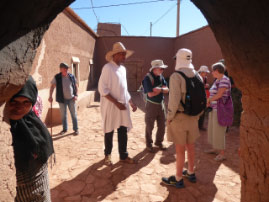
Ait Benhaddou-Day in the life |
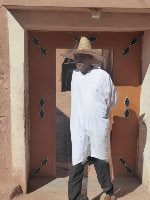
Ait Benhaddou-Day in the life |
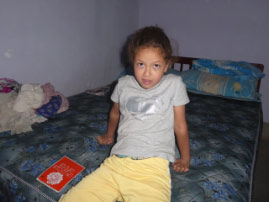
Ait Benhaddou-Day in the life |
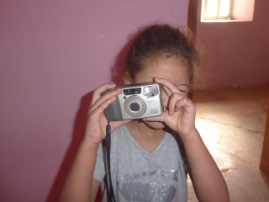
Ait Benhaddou-Day in the life |
I do take a minute to document some of the typical things in a Berger home:
- Kitchen with its wood burning stove;
- China cabinet with coveted family treasures; and
- Living room with a sofa and table decorated in brightly colored fabrics (which serves as the communal family bedroom at night).
I say “good bye” to my little friend at the door. She is with her grandmother and wearing the white scarf I bought for myself in Fez. I really like that scarf, but I like it better on her.
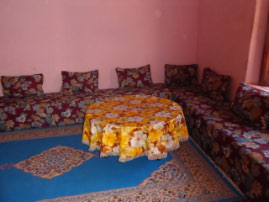
Ait Benhaddou-Day in the life |
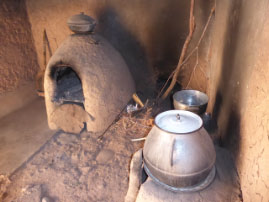
Ait Benhaddou-Day in the life |
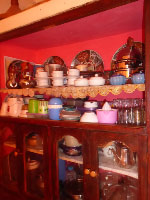
Ait Benhaddou-Day in the life |
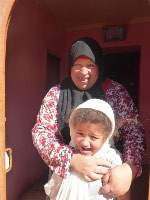
Ait Benhaddou-Day in the life |
Our guide takes us out of town and through a dry river bed to meet the women who work in the fields, cutting the grass, harvesting the crops, and plowing the land. We don’t see any men working the fields (which is typical). The women, like all the other Berber women (probably in their 40’s) are very friendly. One shows Jerri (from Florida) how to use a knife to cut some thick roots – much harder than one would suspect. After our trek through the farms, we wind our way through an olive tree grove and then return to the town for some mint tea. It’s a quaint place and very quiet today. However, back in its day, lots of movie stars and crew stayed here. If these walls could talk!
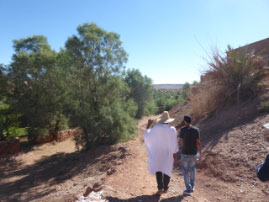
Ait Benhaddou-Day in the life |
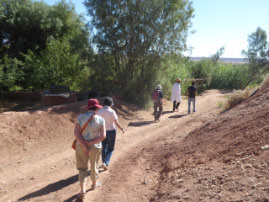
Ait Benhaddou-Day in the life |
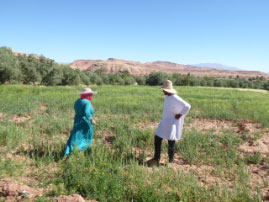
Ait Benhaddou-Day in the life |
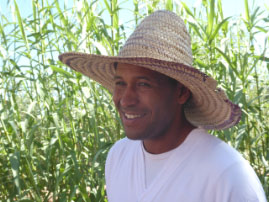
Ait Benhaddou-Day in the life |
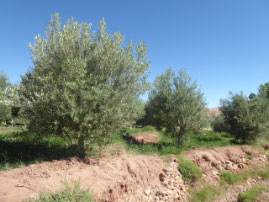
Ait Benhaddou-Day in the life |
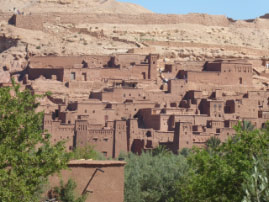
Ait Benhaddou-Day in the life |
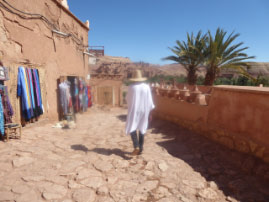
Ait Benhaddou-Day in the life |
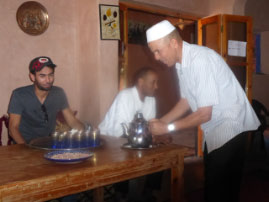
Ait Benhaddou-Day in the life |
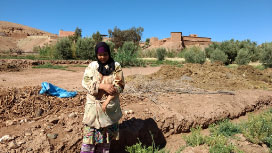
Ait Benhaddou-Day in the life |
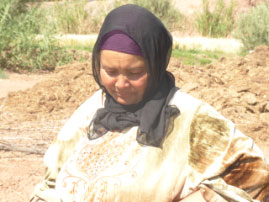
Ait Benhaddou-Day in the life |
Next, we stroll deeper into the town, admiring the beautiful Berber rugs displayed on the outside walls of the shops. (Many in our group wanted to buy … but no time to shop!)
We visit the Imik Smik Women’s Association for Rural Development. Established in 2012, the association’s goal is to help women in rural Morocco. They conduct workshops to teach girls and women how to sew, read, cook, and administer basic healthcare. The women’s’ group generates funding through donations and by selling bread, pastries, and couscous to local guesthouses in the village. The women can also generate some money by selling their handicrafts.
We have tea first, of course, and then listen to the stories of some of the women. We learn that many of their men – husbands and fathers – aren’t on board and don’t like “their women” spending so much time here. However, some men are slowly changing their attitude as the association grows and prospers. For many women, it’s absolutely a lifeline and a life changer.
After the discussion, we divided into groups to learn how to make couscous and cookies. We had no idea so much work goes preparing couscous. Us westerners only know how to make couscous by opening a box. Couscous only contains two ingredients -- moistened semolina wheat and flour, but it’s the shifting over and over again required to get just the right consistency -- and that takes time and know-how. (Our couscous turned out to be delicious – but given the choice, I’d rather settle for less favor and open a box and boil for 5 minutes.) The cookie chefs have trouble keeping the buttery dough together in the heat in order to roll out and cut it into perfect little shapes. We have a lot of laughs at our pitiful attempts.
Next, we walk a few blocks in town to have a lovely home-hosted lunch – a tagine dish made by the women along with our handmade couscous and cookies. Much to our surprise our sad sack cookies were quite delicious.
After we gorge ourselves, Rex and Kathy dress in traditional wedding attire – fitting (or not fitting) because it’s their 50th wedding anniversary today. Margaret (from NC), gets to dress as their attendant. Nour shares a silly you-tube video to keep us of entertained while the Berber women do a henna design for each of us. Bill and I were the last ones. With everyone ready to go, I came up with a quick and dirty design to honor our granddaughter, Zion, who is sweet 16 today. Happy Birthday Honey! We miss you!
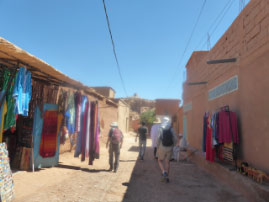
Ait Benhaddou-Day in the life |
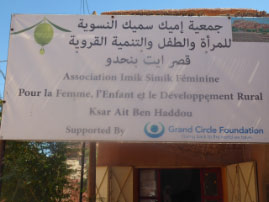
Ait Benhaddou-Day in the life |
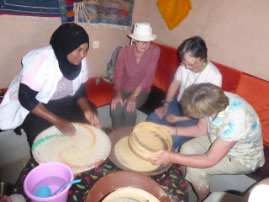
Ait Benhaddou-Day in the life |
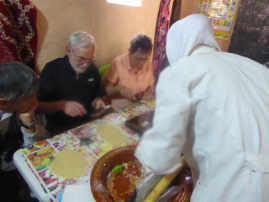
Ait Benhaddou-Day in the life |
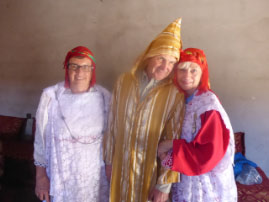
Ait Benhaddou-Day in the life |
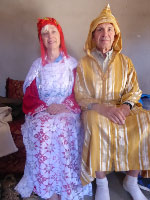
Ait Benhaddou-Day in the life |
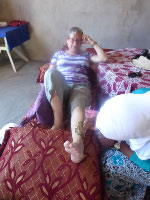
Ait Benhaddou-Day in the life |
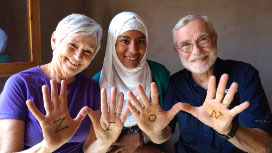
Ait Benhaddou-Day in the life |
After a fun filled day, we arrive back at our lovely hotel resort for Pool Time and Happy Hour! Kathy goes for the special cocktails because she’s been married 50 years today and deserves it! We eat at the hotel tonight – what a spread to celebrate Rex and Kathy’s 50th anniversary and Margaret’s (Ca.) birthday.
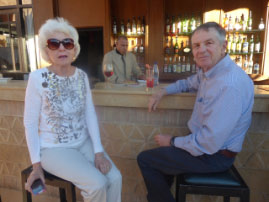
Celebration Dinner at the hotel |
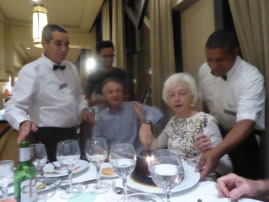
Celebration Dinner at the hotel |
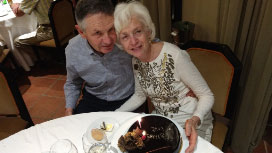
Celebration Dinner at the hotel |
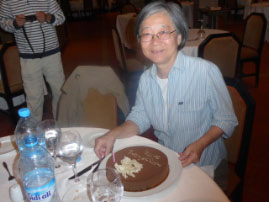
Celebration Dinner at the hotel |
Saturday, May 6 – Ouarzazate over the High Atlas Mountains to Marrakesh
We say good-bye to our desert oasis and drive about 150 miles through the High Atlas Mountains en route to Marrakesh.
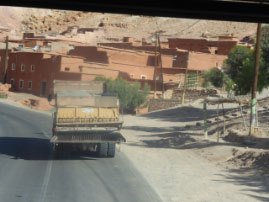
Over the High Atlas Mountains |
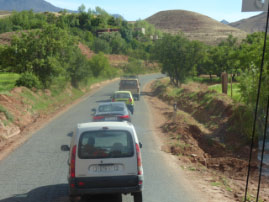
Over the High Atlas Mountains |
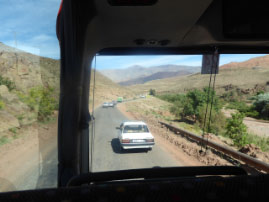
Over the High Atlas Mountains |
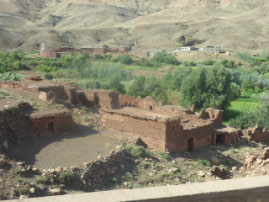
Over the High Atlas Mountains |
We stop at a shop that sells Argan oil. Because I’m not into make-up or skin care, I didn’t know about Argan Oil. Apparently it’s is a miracle product (for me, possibly snake oil) touted for treating a wide range of skin issues (dry skin, eczema, acne, wrinkles, etc.) and numerous medical problems. I wonder how one product can cure everything.
Argan oil is extracted from the kernels of the fruit that comes from the Argan tree, native to Morocco. It’s not cheap because it’s very hard to extract this oil.
The Berber women of this region produce Argan oil as a home based industry. For centuries, they harvest the Argan fruit, remove the pulp and dry it in the sun to get the kernels. They crack the kernels, roast them, grind them to produce a thick liquid, which is filtered to yield an Argan oil that is edible. We watch the Berber women pounding away at the kernels, while chasing their children around the store.
Surprisingly enough, goats love to eat the Argan fruit. In places outside Essaoira, a Moroccan west coast town, goats actually climb the trees to get the fruit. The kernels pass through their intestines making them softer to crack. After the onerous job of collecting kernels from the goat excrement, the women go through the same traditional method in making the oil.
For big industry commercial production, they use unroasted kernels and extract the oil using a cold press. This unfiltered Argan oil is the one which is best for skin care, but is not edible.
I am shocked by the prices and go away empty-handed but did pick up an appreciation of what it takes to make just a little Argan oil.
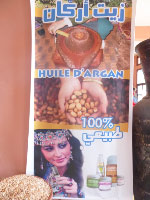
Argan oil shop |
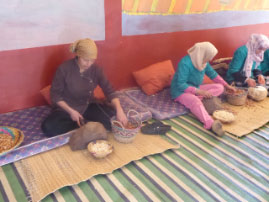
Argan oil shop |
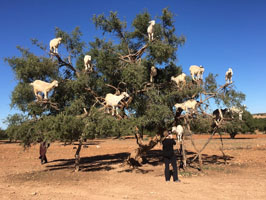
Goats in Argon Tree |
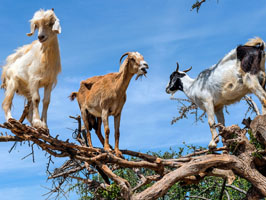
Goats in Argon Tree |
The rest of the day’s road trip is spectacular. With its vistas high above narrow green valleys and twisty rugged mountain roads, it is truly one of the most beautiful drives I’ve ever been on.
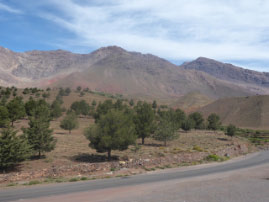
Over the High Atlas Mountains |
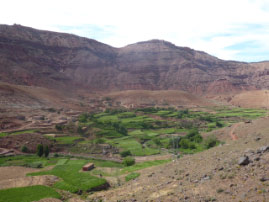
Over the High Atlas Mountains |
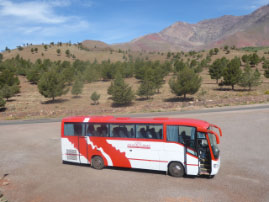
Over the High Atlas Mountains |
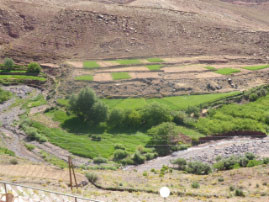
Over the High Atlas Mountains |
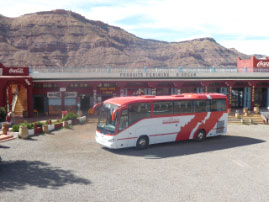
Over the High Atlas Mountains |
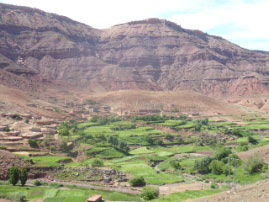
Over the High Atlas Mountains |
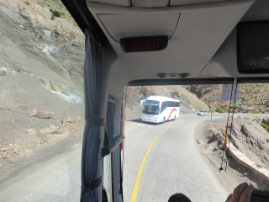
Over the High Atlas Mountains |
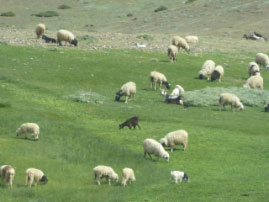
Over the High Atlas Mountains |
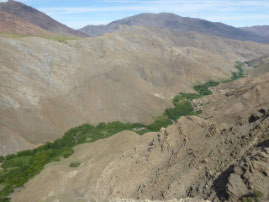
Over the High Atlas Mountains |
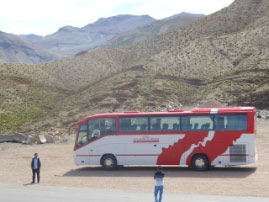
Over the High Atlas Mountains |
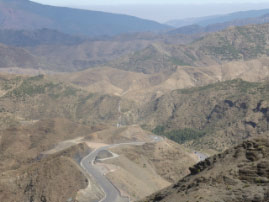
Over the High Atlas Mountains |
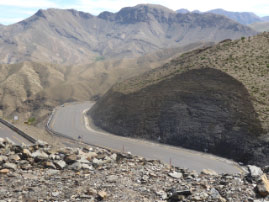
Over the High Atlas Mountains |
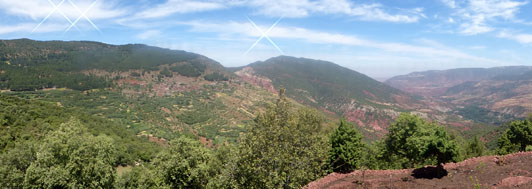
Over the High Atlas Mountains |
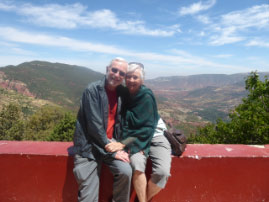
Over the High Atlas Mountains |
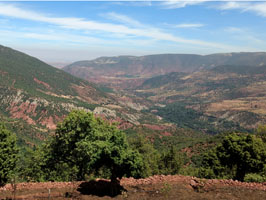
Over the High Atlas Mountains |
We arrive in the “Red City” of Marrakesh. We have 3 days to take in all the exotic shops, squares, markets, medinas, etc. I’m anxious to dive into Marrakesh. But Nour reminds us were in a “big city” now and cautions us about pick pocketers.
Our riad is close to the main market and absolutely charming (Riad Bahia Salam). We have a nice lunch at the riad on the top floor overlooking the city. We like our room – the Casablanca suite. The accommodations on this trip have been tops!
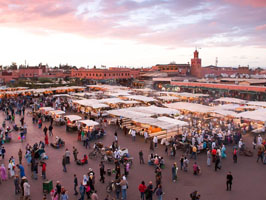
Marrakesh Market |
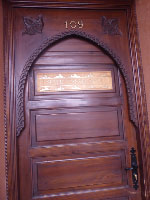
Riad Bahia Salam |
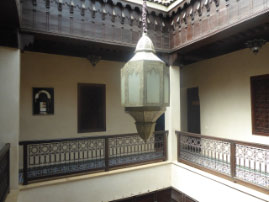
Riad Bahia Salam |
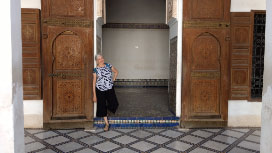
Riad Bahia Salam |
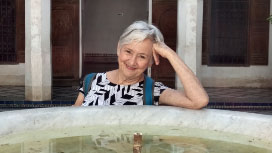
Riad Bahia Salam |
After lunch, Nour walks us to the nearby marketplace and points out important landmarks – like the towering minarets to navigate by. He also shows us where to get our dollars exchanged; where to find a bar that serves alcohol; and some of the local hole in the wall places to get a nice, cheap meal. He is most concerned about us getting lost. The streets go every which way making it easy to get disorientated. If you find yourself lost in the narrow alleyways, it’s like being trapped in a rat maze – we’ll have a chance to experience that later.
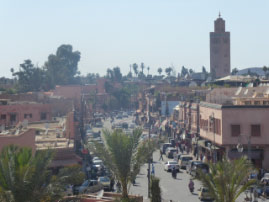
Marrakesh |
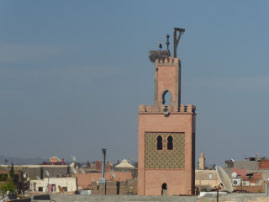
Marrakesh |
We all go our separate ways to explore Marrakesh. The Jamaa el Fna is in the heart of the Medina and close by is the Kosy Bar where we meet up with Rex and Kathy.
To get to find a spot at the Kosy Bar, we enter a charming old 4 or 5 floor building tucked away in the corner of the square. We climb upstairs passing urban looking bars and restaurants. It is the roof terrace that takes our breath away. We grab a table overlooking the square below with views of the massive stork nests around the wall of the El Badi Palace right down to the Koutoubia Mosque.
We return the next evening for another cold beer served up with a great sunset and lots of laid back ambience.
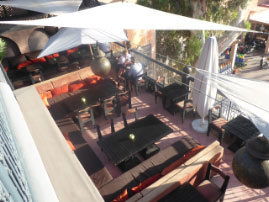
Kosy Bar |
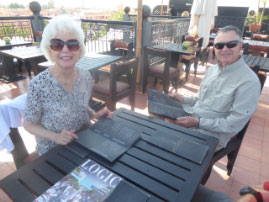
Kosy Bar |
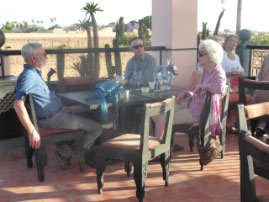
Kosy Bar |
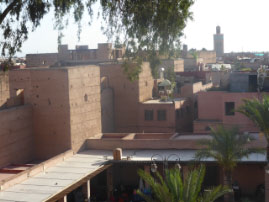
Kosy Bar |
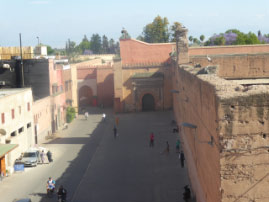
Kosy Bar |
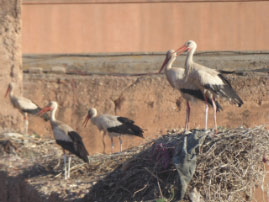
Kosy Bar |
We’re happy to be settled into Marrakesh. After Happy Hour at the Kozy Bar, we link up with Eugene and Gene (Walnut Creek) and grab some authentic street food with the locals in the market square near our hotel (riad). Beautiful day!
| 










